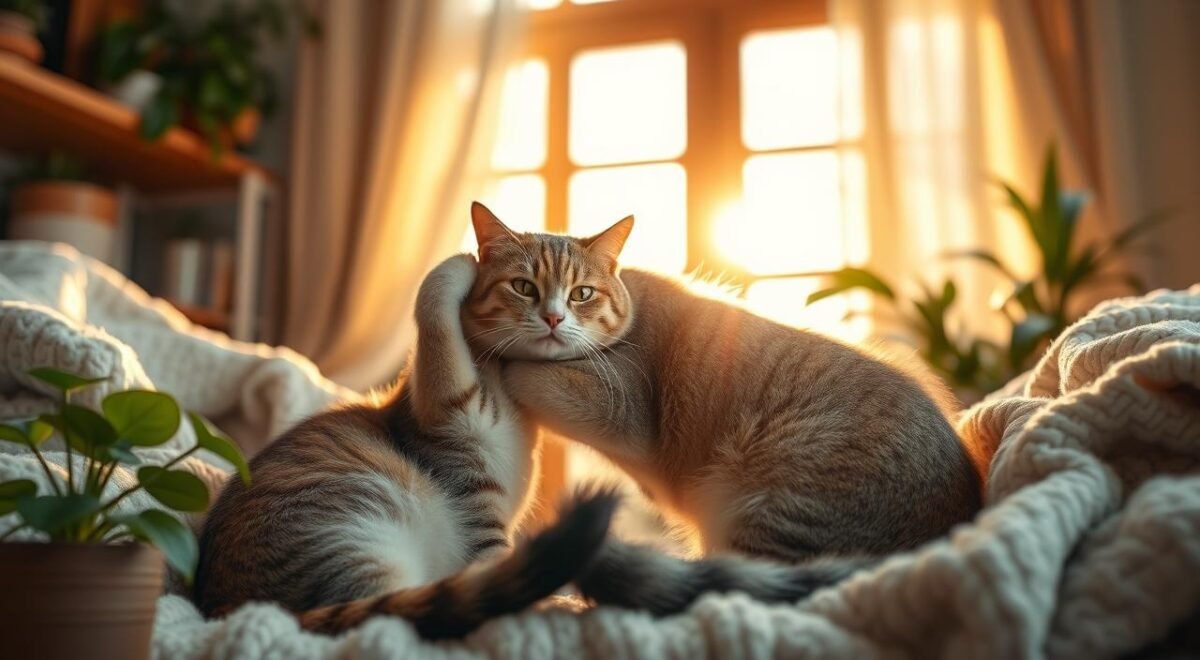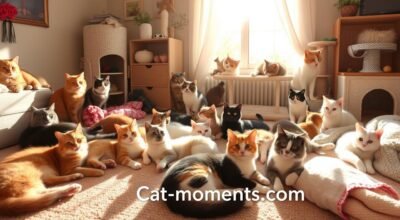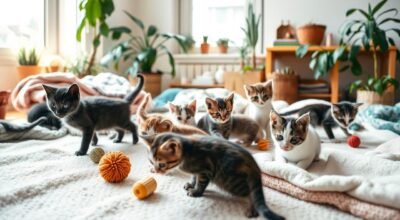Cats are known for their detailed grooming habits. But did you know they also groom each other? This behavior, called mutual grooming or “allogrooming,” is key to their social bonding. It shows how cats interact and form relationships with each other.
Key Takeaways
- Mutual grooming, or allogrooming, is a vital part of feline social behavior and bonding.
- Cats engage in allogrooming to strengthen social ties, establish dominance hierarchies, and communicate through scent marking.
- The evolution of social grooming in felines has been influenced by their natural survival strategies and adaptations.
- Allogrooming helps cats maintain their coat condition and promotes overall health and well-being.
- Grooming rituals among cats can be indicators of trust, affection, and the strength of their relationships.
Understanding Allogrooming: The Science Behind Cat Mutual Grooming
Cats are known for their detailed self-grooming habits. But did you know they also engage in allogrooming? This mutual grooming keeps their fur clean and is key in their social interactions and communication.
The Evolution of Social Grooming in Felines
Allogrooming, or cats grooming each other, comes from their evolutionary history. It helps them build social bonds, establish hierarchies, and keep their group together. Through scent exchange and gentle tongue caresses, cats share vital information about their status and feelings.
Chemical Communication Through Grooming
During allogrooming, cats share chemical signals that reveal their social interactions. Pheromones from scent glands on their face, paws, and body convey identity, mood, and social standing. By grooming each other, cats spread these pheromones, marking their scent on companions and strengthening their bonds.
The Role of Scent Glands in Social Bonding
The placement of scent glands is key in cat social bonding through allogrooming. Cats groom areas rich in these glands, like the head, neck, and tail base. This creates a shared scent that strengthens their connections and sense of belonging in the group.
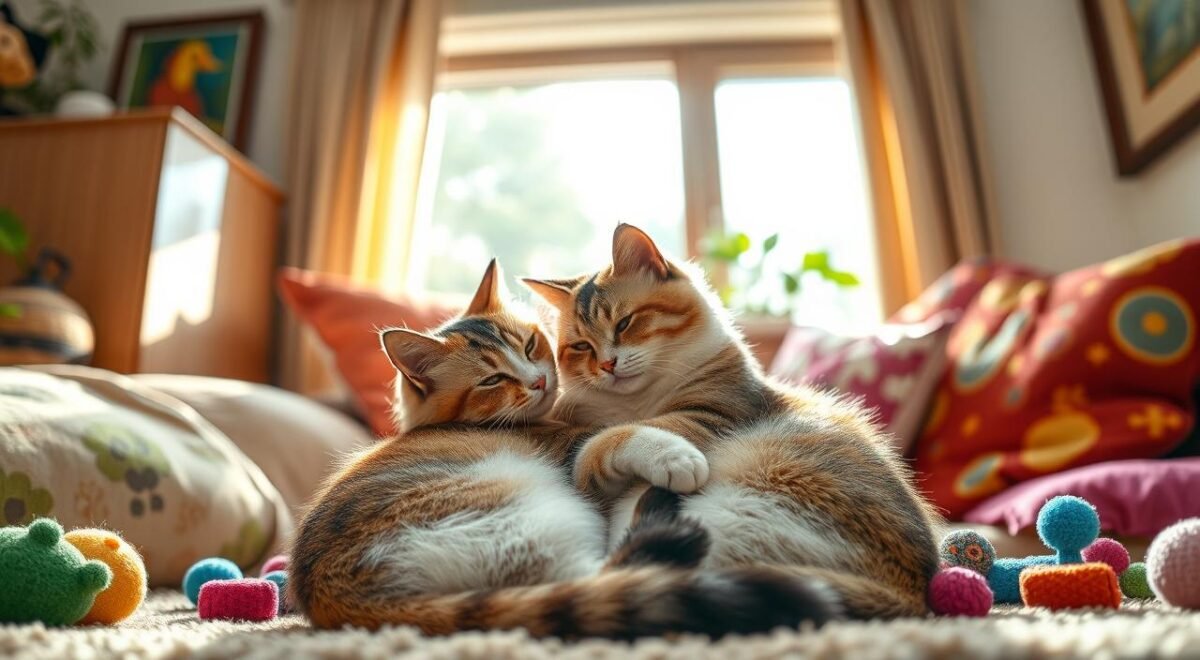
“Mutual grooming in cats is not just about keeping their fur clean, but rather a complex social behavior that helps strengthen their bonds and communicate with one another.”
Why Do Cats Groom Each Other?
Cats have a special way of cleaning each other called mutual grooming, or allogrooming. This act helps them bond and stay clean. As cat owners, knowing why they do this can help us understand them better.
One main reason is to strengthen their social bonds. Grooming releases oxytocin, a hormone associated with trust and affection. This hormone helps cats feel closer to each other. It’s especially common among cats that live together, helping them get along.
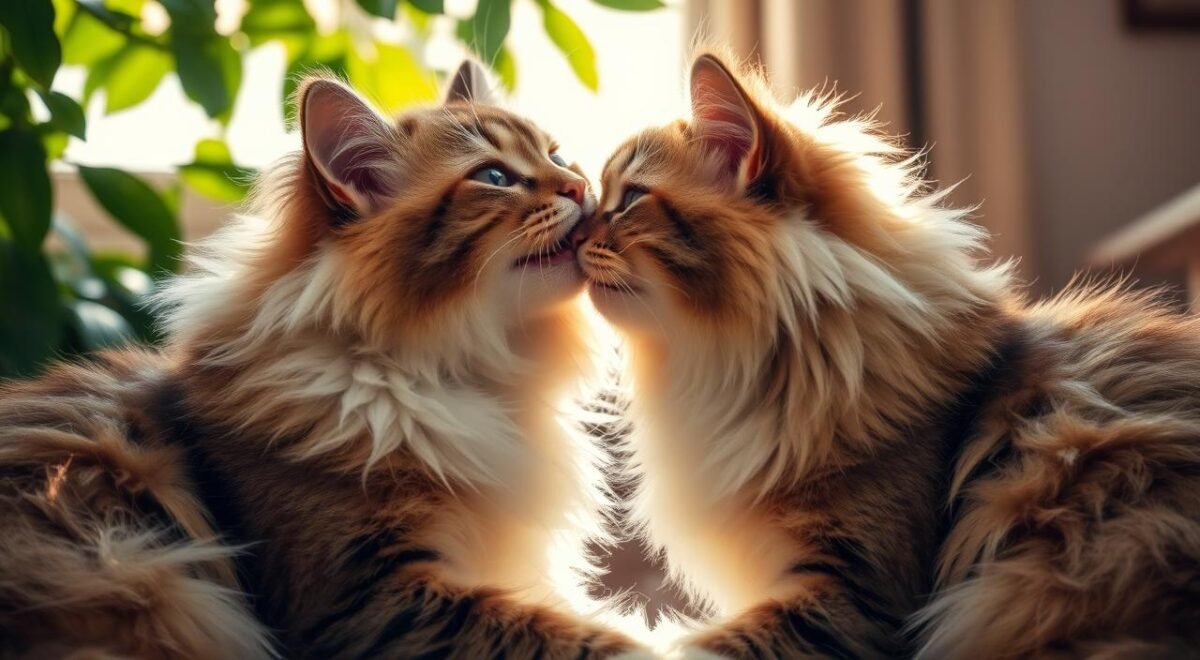
Grooming also has practical uses. Cats can’t always reach every part of their body. By grooming each other, they keep their fur clean and free of dirt and parasites. This helps the whole group stay healthy.
“Grooming is a fundamental part of a cat’s social and hygienic behavior, and it’s fascinating to observe the intricate dynamics involved.”
Grooming also helps cats relax. The gentle motions and feeling of care from another cat can reduce stress. It makes them feel safe and secure.
In summary, cats groom each other for many reasons. It’s about bonding, staying clean, and managing stress. By understanding these rituals, we can appreciate the complex relationships in the cat world more.
The Social Hierarchy and Grooming Dynamics in Cat Colonies
In cat colonies, grooming is key to social order. It helps establish who’s in charge and who’s not. This behavior is vital for bonding and marking territory.
Dominant vs. Submissive Grooming Behaviors
In cat colonies, grooming shows who’s boss. Dominant cats start and control grooming. Subordinate cats accept this, showing respect.
This unequal grooming keeps the social order. It makes sure everyone knows their place.
Group Bonding Through Mutual Grooming
- Mutual grooming, or allogrooming, is vital for cat social interactions and feline social bonding.
- Cats groom each other to strengthen their bonds. It helps the group stay together and feel like family.
- This shared grooming makes cats feel closer. It reaffirms their place in the group and sense of belonging.
Territory Marking and Social Recognition
Grooming also marks territory and recognizes individuals. Cats spread their scent through grooming. This tells others they’re there.
This scent-marking helps cats know who’s who. It keeps the cat colony dynamics clear.
| Grooming Behavior | Purpose | Social Implications |
|---|---|---|
| Dominant Grooming | Reinforcing social hierarchy | Establishing and maintaining dominance within the colony |
| Mutual Grooming | Strengthening social bonds | Promoting group cohesion and a sense of belonging |
| Scent Marking | Territorial communication | Identifying individual members and maintaining social recognition |
The cat colony dynamics and feline social bonding are closely linked to grooming. Understanding these behaviors gives us insight into cat social interactions.
Health Benefits of Mutual Grooming Between Cats
Cats are known for their detailed grooming habits. But did you know that grooming each other, or allogrooming, has many health benefits? This behavior improves cat hygiene and strengthens their bond. It also reduces stress and creates a peaceful home.
One big plus of mutual grooming in cats is a better coat condition. They can clean areas they can’t reach alone. This keeps their coat healthy, shiny, and warm.
Mutual grooming also boosts a cat’s mood. It releases happy hormones like oxytocin, lowering stress and anxiety. This makes cats feel safe and connected, building a strong bond.
“Mutual grooming is an essential component of feline social interactions, serving as a tangible expression of trust and affection between cats.”
Also, grooming helps cats understand their social order and territory. They share scents to recognize each other. This makes them feel part of the group.
In summary, mutual grooming is great for cats’ health. It keeps them clean and happy. It also strengthens their social bonds and improves their life quality.
Signs of Trust and Affection in Feline Grooming Rituals
Feline grooming rituals show a lot about how cats communicate and bond. By watching their body language and sounds, we learn about their trust and affection. These moments are key to understanding cat social interactions.
Body Language During Grooming Sessions
Cats show trust and comfort through their body language during grooming. They might have relaxed eyes, a swishing tail, and knead with their paws. These signs mean they’re enjoying the grooming.
They might also lean into or nudge the groomer. This shows they accept and appreciate the moment. It’s a sign of social bonding.
Vocalizations and Their Meanings
The sounds cats make during grooming tell us about their feelings. A purr means they’re happy and their bond is growing. But a hiss or growl can mean they’re uncomfortable or want it to stop.
Understanding cat grooming rituals helps us see their social lives. It shows the trust and affection in cat colonies and between cats. This knowledge makes us appreciate our feline friends more.
When Cat Grooming Behavior Becomes Excessive
Regular grooming is normal and healthy for cats. But, too much grooming can mean there’s a problem. It can cause bald spots, skin issues, and even harm in extreme cases. It’s key for owners to spot when grooming gets too much and find the cause to help their cat.
Cats groom too much for many reasons like stress, allergies, or health issues. Watching your cat’s grooming habits closely can help find the cause. A vet visit is important to check for health problems and find a solution.
When cats groom each other too much, it’s important to look at the household dynamics. Giving cats enough play, enrichment, and stress relief can help. This can reduce the need for too much grooming and keep the cat family happy and balanced.
FAQ
Why do cats groom each other?
Cats groom each other for many reasons. This behavior is key to their social bonding. It helps them feel closer, reduces stress, and keeps them clean.
How does allogrooming contribute to social bonding in cats?
Allogrooming is vital for cats’ social bonds. It lets them share scents and touch, which strengthens their relationships. It also helps them show affection and establish who’s in charge.
What is the role of scent glands in cat grooming behavior?
Cats have scent glands in their paws, cheeks, and head. When they groom, they share these scents. This is how they communicate and recognize each other in their group.
How do dominant and submissive cats differ in their grooming behaviors?
In cat colonies, grooming shows who’s in charge. Dominant cats groom the others. Submissive cats groom their superiors to show respect and trust.
What are the health benefits of mutual grooming in cats?
Mutual grooming is good for cats’ health. It makes their coats shiny, lowers stress, and strengthens their bonds. It also keeps them clean and mentally active.
How can I recognize signs of trust and affection in my cats’ grooming rituals?
Look for relaxed postures, gentle licking, and purring during grooming. These signs show trust and affection between cats. They indicate a positive interaction and bond.
When does cat grooming behavior become excessive?
Regular grooming is normal for cats. But too much or compulsive grooming can mean stress, anxiety, or health issues. If your cat is grooming too much, see a vet.
